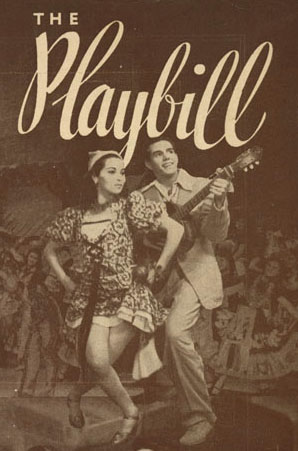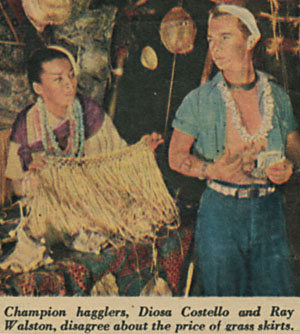| In 2001 I was listening to a then-new CD of classic Puerto Rican music (Lamento Borincano, Arhoolie Records 7037-38), and there I heard for the first time this most remarkable voice, identified as Diosa Costello, singing with the Pedro Flores Sexteto the great song "Siboney". Surprised that I had never heard of such a remarkable singer, I began asking around about her among Puerto Ricans and music afficianados. Most had never heard of her; some remembered the name, but few remembered her as Puerto Rican. I set out to find out what I could about her: who was she, where had she come from, what else had she done, and why wasn't she better known? It took me several years, but I did find a lot. I first presented this research publicly in 2004 at the conference of the Puerto Rican Studies Association, then in 2005 at the 11th Annual Latino Issues Conference at Bowling Green State University. In early 2005 I finally managed to contact Diosa herself; after many telephone conversations we met in San Juan in January 2006, and in the summer of 2006 I went with my wife, Vilma Santiago-Irizarry, and a crew from the Smithsonian Institution to interview her in Las Vegas. Publications are in preparation, and we hope to interest a production company in her story for broadcast, but for now I wanted to make this remarkable story public through my website. | 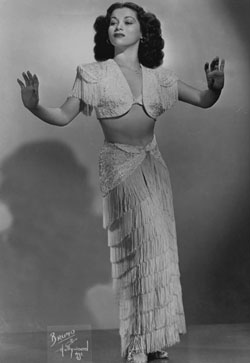 |
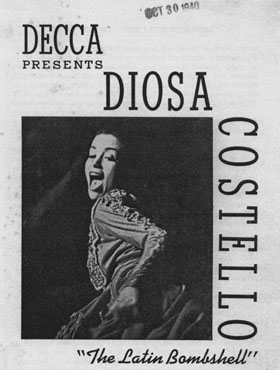 |
Born Juana de Dios Castrello in Guayama, Puerto Rico, Diosa - as she was known to her family - always loved to dance. Her father was a traveling merchant, but died when she was a young girl; she remembers dancing to entertain him as he lay in bed ill with pneumonia. After his death, her mother moved with the family to San Juan, to a house near El Morro. There she would find ways to escape to sing and dance in the streets for pennies the soldiers would give her. Overwhelmed, her mother sent Diosa and a sister to live in the Hogar Insular de Niñas in Miramar, from which she could see the Hotel Condado; when told what that was, she decided that one day she would perform there.
She left school after the eighth grade and the family moved to New York. Soon Diosa was sneaking out to perform in the chorus at the Teatro San Jose, and she won a contest to record with Pedro Flores's sexteto while in her teens. She soon took the stage name Diosa Costello, and quickly gained fame performing in clubs and theaters in Spanish Harlem. Latin dance was growing in populararity at the time, and she was discovered and brought downtown to the famous club La Conga, where she teamed with the then-unknown Cuban conga player Desi Arnaz. |
|
Diosa's act was always a large part comedy along with her singing and acting, and involved a lot of humorous audience participation. Desi was among the first Latin performers Diosa helped along, but there were many others. She doesn't take much credit, though, saying they wouldn't have made it if they didn't have the talent on their own; she just helped open some doors along the way. Broadway producer and rhumba fanatic George Abbott loved dancing with Diosa - they called themselves Abbott and Costello for fun - and he wanted her for a Rodgers and Hart show he was producing, Too Many Girls. Diosa convinced him to have a part added for Desi, and the show opened on Broadway in 1939. It was very popular, and was soon optioned for a Hollywood film. Desi went to Hollywood for the film, but Diosa - who never liked traveling much - stayed in New York. In Hollywood they cast Ann Miller in Diosa's part, and another part went to a rising young starlet named Lucille Ball. Lucy and Desi were soon an item (the tabloids reported that Diosa was furious, but at least in later years they all got along fine). In early 1941 Diosa was brought in when Ed Sullivan tried to revise an unsuccessful review show, Crazy with the Heat, but the revival was not much more successful than the first run. She later starred with Chico Marx in another variety review, Curtain Time, that toured the country in 1943. Diosa remembers convincing producers to hire Desi, telling them, "well, he plays the guitar - not so good - and he plays the congas - not so good - but look at that face! The girls will love him!" He was also a charismatic performer, of course - like Diosa - and the two made a great pair on stage. |
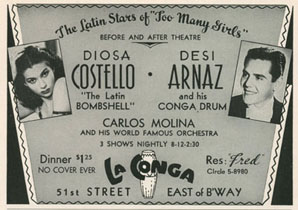
|
| Also in 1941 Diosa made her first attempt at Hollywood filming, appearing opposite Buddy Ebsen as a comedic couple in the Good Neighbor Policy film They Met in Argentina. The film showcased both their dancing and comedy, and like Too Many Girls it was a Rodgers and Hart production - so at least some of the music was good, although some probably marks a low point for their career!
Diosa never enjoyed movie-making; she liked to improvise, and hating being told she had to do things just-so. She also didn't like the standing around waiting, or the lack of a live audience. She did do a couple of other movies, however, including 1945's The Bullfighters, the last Hollywood film of Laurel and Hardy. That film featured her in a nightclub performance that was basically part of her regular show in the '40s, offering a rare glimpse of her stage act. Through the 1940s Diosa worked primarily as a nightclub performer, working clubs around the country although New York was her home base. During that period she married Cuban bandleader Pupi Campo (himself a fascinating performer, an early inspirational partner to Jerry Lewis and Dean Martin, later the original bandleader for Jack Paar but fired after he married singer Betty Clooney; we also interviewed Pupi with the Smithsonian crew in June 2006), but they divorced a few years later. |
| In early 1950 Diosa was tapped to play Bloody Mary in the original touring company of South Pacific, opening in Cleveland in April. She remembers having to be strongly persuaded by director Josh Logan to take the part; she didn't see herself as that Pacific Islander character, especially since her own style was very different from that of Juanita Hall, who originated the character on Broadway. Very nervous, she took vocal lessons to polish her elocution, only to have Logan tell her "No! I want you to play it your way!"
Diosa considers this her greatest performing challenge, but she was quite successful. After over a year of touring with the show she followed Juanita Hall in the part on Broadway, and performed there for another seven months, through early 1952. For years after she included her numbers from the show - particularly "Happy Talk" and "Bali Hai" - in her nightclub act, and we even got her to sing a little of "Happy Talk" when we interviewed her in 2006 (her voice is still very nice!). She also sang these in the 1975 tribute performance for Joshua Logan at the Imperial Theatre in New York, which was recorded and offers the chance to hear her performance in full. Throughout the 1950s Diosa played nightclubs across the country, with repeat visits to Miami and Las Vegas as well as New York. She returned to Hollywood once more for Miss Sadie Thompson, the Rita Haworth film, where she essentially reprised her character of Bloody Mary from South Pacific. Much of her work for this film was left on the cutting room floor, but the film is remarkable for featuring three major Latin performers - Jose Ferrer, along with Diosa and Rita - with none of them playing a Latino character! This ethnic invisibility characterized Diosa's entire career, as it did many Latin - and especially Puerto Rican - performers in the US through most of the twentieth century. She was seldom billed as Puerto Rican, more often as "Latin", but also as Cuban, Brazilian, and Mexican. In Diosa's case it is even more ironic, as she became best known for playing a Pacific Islander. |
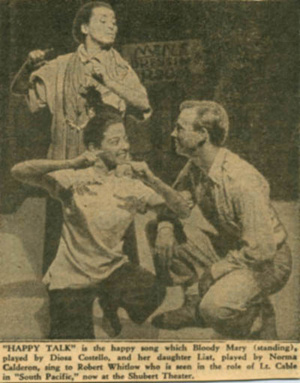
|
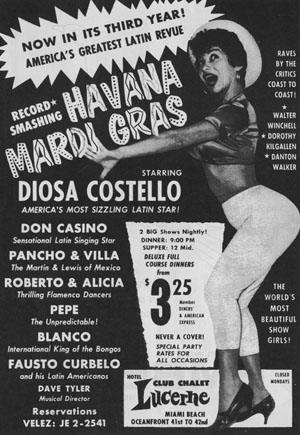 |
In 1959 Diosa staged a long-running show at the Lucerne Hotel in Miami Beach, where she met an Italian singer named Don Casino. They were married in the early 1960s, and Diosa opened her own club at the Hotel Saxony there. She also took her nightclub show to Puerto Rico at least twice in the 1960s, fulfilling that childhood dream of performing at the Condado Hotel (one of her chorus dancers she took to Puerto Rico was the young Goldie Hawn).
Diosa and Don Casino broke up after a few years, and Diosa decided to leave show business. She had remained friends with Pupi Campo's family, and one of Pupi's brothers helped Diosa to get re-established in Las Vegas, as a blackjack dealer. She spent the rest of her working years in that career, and loved it; she got to be around people, working nights. When I reached Diosa in 2005 she was enjoying her quiet retired life, as she likes to say, watching her soaps and going out bowling. She has always been one to live in the moment, not in the past, and had turned down previous inquiries to film biographical projects and to consult on the remake of South Pacific a few years ago. But we developed a friendship, and I convinced her that others would be interested in her story. Here I have only touched on the highlights, but there is more to be told even beyond what we have recorded. And there are many other forgotten Latin performers whose stories deserve to be recorded as well. |
| Vilma and I have family and friends in Puerto Rico, so we go back with some regularity. Diosa had not been back to the island for almost 20 years, and as we talked about how things have changed there we hatched the idea to meet there. Diosa also wanted to find something she could do to benefit children in Puerto Rico, especially orphans. We arranged to travel there at the same time, and we actually met for the first time there in January 2006. Diosa didn't want to make a big deal of her return, but we did arrange a small number of newspaper interviews and television appearances. We took her back to see Guayama, with her sister, and did what we could to help her find a suitable way to help the children. And Diosa took us to meet her longtime friend Ruth Fernandez, who kindly hosted us in her home. Here you see Vilma and Diosa on the first night we met, in San Juan. | 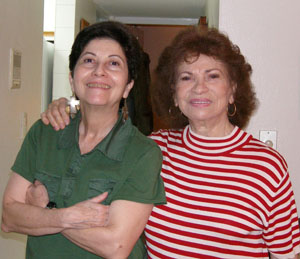 |
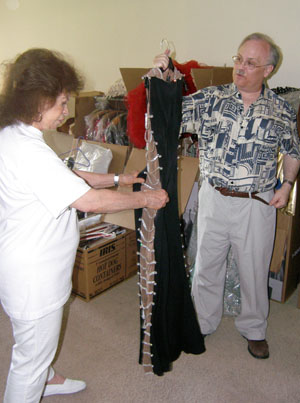 |
Smithsonian curator Marvette Perez had been interested in my research on Diosa from the beginning. In November 2005 she introduced us to fellow curator Dwight Blocker Bowers, and we began to make plans to record a series of interviews with Diosa and perhaps have her donate some materials to accompany the interviews to the Smithsonian. In June 2006 we all went out to Las Vegas to do this, with the assistance of Ranald Woodaman, also of the Smithsonian, and with the support of the Film Department at UNLV, where a public interview was filmed. We all had a wonderful time with Diosa, and also with Pupi Campo, whom we spent an afternoon with at the Community College of Southern Nevada, where his son Carlos is Dean of Arts and Letters. The Smithsonian materials will be archived by the National Museum of American History and the Smithsonian Center for Latino Initiatives. In the photo at left Diosa is explaining the history of the costume Dwight is holding. |
| Over the past 5+ years I have accumulated many photographs, advertisements, magazine and newspaper clippings, recordings, and other materials relating to Diosa Costello, which have formed the backbone of this research. Diosa herself has been surprised by some of the things I've found! These too will probably go to the Smithsonian eventually, but for now I am still enjoying having them around.
There are significant scholarly and analytical issues that are illuminated by consideration of Diosa's career, particularly concerning the gendered ethnoracial stereotypes that shape how she and other Latinas were and are perceived in the United States. But for me, the story is compelling and interesting for its own sake, and as I came to know her Diosa became more a friend than someone I was interested in studying. She was and is a remarkable woman, someone who has repeatedly found herself in situations that required ingenuity and creativity to get through, and she has always responded in that way. She has an admirable ability to see the bright side of things, and a concern for others that we all should emulate. I count myself highly privileged to have gotten to know Diosa Costello. |
all materials © Frederic Gleach
photographs not to be reproduced or otherwise used without permission
source: www.gleach.com
